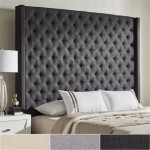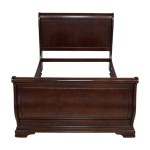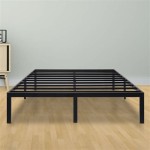Bed Size Full vs. Queen vs. King: Choosing the Right Fit
Selecting the right bed size is a crucial decision impacting sleep quality and bedroom aesthetics. This article explores the dimensions, benefits, and drawbacks of full, queen, and king-sized beds to guide consumers toward an informed choice.
Dimensions: A Comparative Overview
Understanding the precise dimensions of each bed size is fundamental to ensuring it fits comfortably within the bedroom space. A full-size bed, also known as a double, measures 54 inches wide and 75 inches long. A queen-size bed provides more space, measuring 60 inches wide and 80 inches long. King-size beds offer the most generous sleeping area, with standard dimensions of 76 inches wide and 80 inches long. Some manufacturers also offer California king beds, which measure 72 inches wide and 84 inches long, providing extra length but slightly less width than a standard king.
Ideal Room Size: Matching Bed to Space
The recommended minimum room size for a full-size bed is 10 feet by 10 feet, allowing for adequate movement around the bed and furniture placement. Queen-size beds ideally require a room of at least 10 feet by 12 feet. For a standard king-size bed, a room measuring 12 feet by 12 feet or larger is recommended to ensure comfortable navigation and prevent a cramped feeling. California king beds, due to their length, benefit from a slightly longer room, ideally 12 feet by 14 feet or larger.
Sleeping Capacity: Singles, Couples, and Families
Full-size beds are generally suitable for single sleepers or occasionally accommodating a second person. They can also be a practical option for guest rooms or smaller bedrooms. Queen-size beds are a popular choice for couples, providing adequate space for two individuals to sleep comfortably without feeling cramped. King-size beds offer ample space for couples, allowing for greater individual space and minimizing sleep disturbances. They can also accommodate children or pets comfortably.
Cost Considerations: Budgeting for Your Bed
The cost of a mattress and bed frame varies based on size, brand, and materials. Generally, full-size beds are the most affordable option, followed by queen-size beds. King-size beds represent the highest investment due to their larger size and the greater quantity of materials required for their construction. Bedding, such as sheets, blankets, and comforters, also increases in cost with bed size. Consumers should factor these costs into their budget when making a decision.
Lifestyle and Preferences: Tailoring Your Choice
Individual lifestyle and sleep preferences play a significant role in determining the ideal bed size. Single sleepers who value ample space might prefer a full-size bed. Couples who prioritize individual sleeping space and minimal partner disturbance might opt for a king-size bed. Those with limited bedroom space might find a queen-size bed offers a good balance of comfort and practicality. Consideration should also be given to factors such as tossing and turning during sleep, pet sharing, and the potential need to accommodate children occasionally.
Moving and Logistics: Practical Considerations
Moving a larger bed can present logistical challenges. Navigating doorways, hallways, and staircases with a king-size mattress and frame can be difficult and may require professional movers. Full and queen-size beds are generally easier to transport and maneuver. Apartment dwellers or individuals who move frequently should consider the potential difficulties associated with transporting a larger bed.
Aesthetics and Bedroom Design: Visual Impact
The size of the bed significantly impacts the overall aesthetic of the bedroom. A king-size bed can create a luxurious and spacious feel, but it can also overwhelm a smaller room. A full-size bed can make a room appear larger, while a queen-size bed often provides a balanced visual appeal. The choice of bed size should complement the room's dimensions and existing furniture to create a harmonious and visually appealing space.
Ultimately, the ideal bed size is determined by a combination of factors, including room size, budget, sleeping habits, and personal preferences. Carefully evaluating these elements ensures a comfortable and satisfying sleep experience.

The Difference Between A Queen And King Bed Bedinabox

King Vs Queen Bed Detailed Mattress Comparison Turmerry

King Vs Queen Bed Size Mattress What Is The Difference Nectar Sleep

King Vs Queen Bed What S The Difference Amerisleep
.jpg?strip=all)
King Vs Queen Size Beds Differences Comparison And Benefits

King Bed Vs Queen B2c Furniture

Queen Vs King Mattress 2024 Nerd

King Vs Queen Size Mattress Dreamcloud

Queen Vs King Bed Size Comparison What Is Better Sleep Advisor

Mattress Guide King Vs Queen Bed Sleepworld







